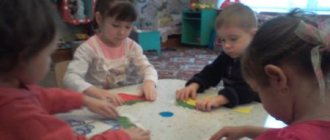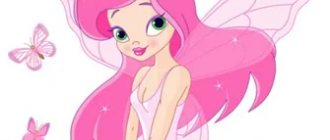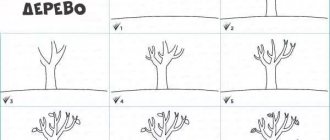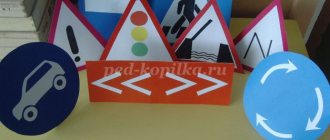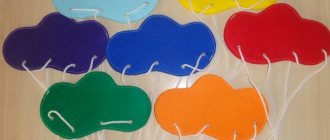Useful Guides
It seems to me that the essence of the problem lies in the fact that integrated lessons in preschool educational institutions began to be held not so long ago. Of course, this is no longer know-how, but this definition entered pedagogy only in the 90s of the twentieth century. In addition, the concept of a complex integrated lesson is often used in the literature. And how can you figure out what the differences are, and even draw up a clear GCD plan?
I think that it will be much easier to study the features of each activity using specific examples. For my part, I can recommend some interesting manuals for teachers, which, it seems to me, give a clear idea of the structure, goals and objectives of both classes.
Complex lessons are conveniently distributed by topic with the expectation that the teacher will be able to conduct them every week, in the book by N. S. Golitsyna “Notes of complex thematic lessons” for the senior group. It seems to me that in the future these notes can be taken as a model when preparing for independent studies and on other topics, since they are well compiled.
By the way, there are similar benefits for preschoolers of different ages. For example, the orientation of this book is already a preparatory group. Notes for the entire academic year are collected here.
As for integrated classes, for conducting them with children of the same age there is a book by the author A. V. Adzhi, which contains notes on such classes for the preparatory group of a kindergarten. In it I found a description of about a hundred activities aimed at the speech development of six- to seven-year-old children and the activation of their cognitive activity.
Of course, I have not provided a complete list of useful benefits here, but have only shared my own experience. I would be glad if you also share useful books on our topic. Tell us, what literature do you use, dear colleagues?
Integrated Learning Models
In addition to the forms, there are such modern models of organizing integrated inclusive education as:
- continuous full integration;
- constant but incomplete integration;
- partial integration;
- time integration;
- episodic integration;
- combined integration.
Continuous full integration
With this model of integrated education, children with inclusion attend a general education school together with other students and receive additional correctional assistance if necessary. Permanent full integration is possible in two cases:
- the child’s level of development is close to normal, without significant deviations;
- In addition to the teacher, the school also has a separate specialist.
Constant but incomplete integration
This model is suitable for children who have deviations from the age norm. They require specialized assistance and cannot attend all classes at the same time as other students. Teachers and parents determine which subjects the child will take with the class, and what is easier to master with the help of a specialist.
Partial integration
In this model, greater importance is given to the individual education of a child with special needs. And he attends classes at a comprehensive school only partially or spends time with children after his main studies.
The earlier developmental features are identified, the greater the chances for successful adaptation.
Temporal integration
In this model of integrated learning, an inclusion child spends time with regular children at school at least twice a month. And he studies individually according to a specially developed program.
Episodic integration
This model is used in schools where it is not possible to organize full-fledged integrated training: there is no separate specialist, there is no opportunity to modernize teaching. In this case, periodic events are organized that help socialize children with special needs.
Combined Integration
A learning model that is used in small localities if they do not have opportunities for any kind of integrated education. In this case, only some elements of inclusive education are used. Therefore, the combined model is suitable for children with minimal developmental disabilities, otherwise they simply will not be able to master the educational program on an equal basis with other students.
Common features of integrated and complex lessons
Agree, it is difficult to understand how a complex lesson differs from an integrated one, also because in the literature one concept is often replaced by another. Have you also probably encountered this problem? There is also a combined lesson. How do you understand what makes it special?
For me, the situation became a little clearer when, armed with the above-mentioned literature and drawing on personal experience, I identified some similarities between integrated and comprehensive lessons:
- The content of both classes is concentrated around one topic, in contrast to the combined one, where, as I understand it, different types of activities simply replace each other.
- Such thematic classes require interdisciplinary connections.
- Both of them are multidirectional, not substantive.
- During them, a logically justified and plot-related change of various types of activity in children (cognitive, physical, speech, musical, artistic) necessarily occurs.
Features of integrated classes
Despite their common features, comprehensive and integrated lessons demonstrate a different approach to learning. Correct me if I'm wrong! What is special about each activity? I'll tell you how I understand this for myself. Perhaps you see the situation differently, I will be glad to see your comments, since the topic is really very complex!
I think that specific examples will make my explanation more clear, so let’s assume that we are considering the topic “Spring” in the senior group of a preschool educational institution:
- By integrating blocks from various disciplines, we will create in children holistic knowledge on our topic, that is, form their idea of spring as a seasonal phenomenon.
- During this lesson, students will definitely gain new knowledge! But at the same time, it is also important that they already have some certain “baggage” of ideas about spring. Otherwise, we simply won’t have anything to base the conversation on, right?
- Planning a lesson involves constructing the material in a certain way, with the construction of a clear and thoughtful scheme. I usually use mind maps. In this case, in the center we will have a key concept (“spring”), and other concepts (seasons, flowers, wintering and migratory birds, the main signs of spring, etc.) will already be logically connected with it. How does preparing notes go for you, tell us?
What is integrated learning
Integration is a technical term that refers to any process of combining parts into a whole. But in the pedagogical system it has its own specifics: it is used in matters of inclusion, that is, the inclusion of people with various types of disabilities in public life.
So, in education, integrated learning is an educational model in which a child with special needs is not taught separately, but together with other children.
Integrated or inclusive education is not only an opportunity for people with developmental disabilities to feel part of society, but also a way to develop tolerance, empathy and caring for others from the first years of life.
Salamanca Declaration
In 1994, the World Conference on Special Needs Education was held in Spain. Within its framework, the Salamanca Declaration was adopted, which formed the basis of the concept of integrated education. Here are its main provisions:
- every child has the right to basic education;
- Each child is unique and has his own interests and different levels of abilities;
- these features should be taken into account in the learning process, creating comprehensive educational programs;
- General education schools must create conditions for comfortable learning for all children, including inclusion.
Thus, basic models of integrated learning began to emerge, which allowed children with special needs to gain access to a full-fledged school education.
The university also uses integrated or integrated learning technologies. But there this term is understood as methods that involve an integrated approach to vocational education. This is achieved through the development of interdisciplinary connections, the use of project work, Agile and Scrum methodologies and other tools.
What is important to remember?
Here is another important property: the types of children’s activities in such a lesson cannot be strictly divided, they will smoothly flow into one another. We can organize the cognitive activity of pupils in such a way that they will remember the different seasons of the year, analyze seasonal changes, learn to distinguish and group spring flowers, migratory and wintering birds.
Then you can unobtrusively move on to a speech game, which takes the form of reading poetry about spring. Physical activity is, for example, the outdoor game “Spring Flowers”, and artistic activity is drawing or appliqué “Snowdrop”.
I think such classes can be conducted in the middle group of preschool educational institutions, only the form of presenting the material, of course, will be simpler. If, for example, you have a 2nd junior group, then the lesson dedicated to spring will most likely be complex, since for kids all the lessons are basically the same.
Well, these are just my examples. How do you conduct integrated classes in kindergarten? Maybe you can still highlight some features that I did not take into account, share your experience!
I almost forgot, I can also recommend you one good manual by N. N. Leonova, “The Artistic and Aesthetic Development of Children 5-7 Years Old.” It contains notes from classes that involve teaching children visual arts in non-standard ways. Very interesting, in my opinion!
The essence of a comprehensive lesson
Well, we’ve dealt with integrated lessons, now let’s move on to complex ones. They are usually built on material already familiar to students. A certain general theme is also taken as a basis, and the diverse activities of students are built around it. For example, the theme of spring could be dedicated to the lesson “The Adventures of the Merry Snowdrop”, “In the Spring Meadow”, etc. You can come up with any name!
Of course, it is assumed that the children already know that the snowdrop is a spring flower, so this will be more likely a middle than a junior group. This is what is important: during this lesson, the children do not expand their knowledge about the properties of this flower and do not learn about why it appears earlier than the others. Snowdrop is only the main character.
Here is how the activities of students united by a common theme can be organized:
- Students’ speech development can take place in the form of an entertaining conversation, during which the teacher will also demonstrate paintings by artists and children’s drawings depicting the arrival of spring. This same stage also includes cognitive activity.
- Next, together with Snowdrop on a cheerful train, the children can go to a spring clearing in the forest (the outdoor game “Chuk-Chuk” for physical development).
- On the way, when they meet a stream, they will sing a funny song with it (musical development).
- In the clearing they will collect and count snowdrops (mathematical development).
- At the end of their journey they will make a spring appliqué (art development).
The change in actions during such an activity is usually very clearly visible. This is explained by the fact that they are aimed at developing certain skills, and not at the formation of holistic ideas about spring, as a seasonal change, in our case.
Again, this is just my example, perhaps you can tell us about some of your interesting activities? Leave your comments, I will be glad to learn from my colleagues!
Integrated learning technology
The concept of integrated learning includes not only a tolerant attitude, but also the use of modern technologies in education. After all, the transition to this type of progressive education requires modernizing the entire school system. Namely:
- attract the necessary specialists who will assist teachers during teaching;
- use innovative pedagogical solutions and ideas;
- adapt the curriculum to take into account the characteristics of all children in an integrated class;
- place emphasis on the development of creative and cognitive abilities;
- actively involve parents in the educational process.
When working with special children, the teacher needs the help of a specialized specialist
Final recommendation
By the way, there is also such a good manual edited by N. E. Veraksa with lessons for children of the older group: “Comprehensive lessons according to the program “From birth to school”.” The book is quite voluminous, but this is good, because in it you can find useful notes for the whole academic year!
Well, I hope I was able to answer your question more or less clearly, dear readers! If there are some points I have not yet covered in my article, then please write about it in the comments! Share your valuable comments on our topic!
I wish you success in conducting a comprehensive or final integrated lesson at your preschool educational institution. Recommend the article to colleagues and friends, and be sure to subscribe to updates, because a lot of useful and interesting things await you ahead.
Sincerely, Tatyana Sukhikh! Till tomorrow!
By the way, I recommend reading:
Forms of integrated learning
According to the organization of the educational process, four forms of integrated learning are distinguished:
- attending a regular secondary school class;
- attending a special class in a secondary school;
- studying in a correctional school with subsequent transfer to a general education school;
- full or partial inclusion in the educational process during vocational training.
By the way! Our readers now have a 10% discount on any type of work.
